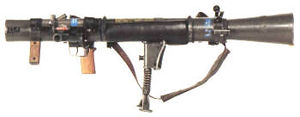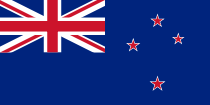Carl Gustav recoilless rifle
| Carl Gustaf Recoilless Rifle | |
|---|---|
 Carl Gustaf Recoilless Rifle |
|
| Type | Multi-role (anti-armor, anti-fortification, anti-personnel, illumination) |
| Place of origin | |
| Service history | |
| In service | 1948 - Present |
| Used by | See Users |
| Wars | War in Afghanistan, Falklands War, Iraq War |
| Production history | |
| Designer | Hugo Abramson and Harald Jentzen |
| Designed | 1946 (M1), 1964 (M2), 1991 (M3) |
| Manufacturer | Saab Bofors Dynamics (formerly Bofors Anti-Armour AB), Howa (license)[1][2] |
| Specifications | |
| Weight | 8.5 kg (rifle); 0.8 kg mount |
| Length | 1.1 meters |
| Crew | Two (gunner and loader), but may be used by a single operator at a reduced rate of fire. |
|
|
|
| Cartridge | 84×246 mm. R |
| Caliber | 84 mm. (3.31 inches) |
| Rate of fire | 6 rounds per minute |
| Muzzle velocity | 230-255 m/s |
| Feed system | Hinged breech |
| Sights | Open (iron) sights; optical 3x; laser rangefinder; image intensification system |
The Carl Gustaf (also Carl-Gustaf and M2CG; pronounced "Carl Gustav") is the common name for the 84 mm man-portable multi-role recoilless rifle produced by Saab Bofors Dynamics (formerly Bofors Anti-Armour AB) in Sweden. The first prototype of the Carl Gustaf was produced in 1946, and while similar weapons of the era have generally disappeared, the Carl Gustaf remains in widespread use today. British troops refer to it as the Charlie G, while Canadian troops often refer to it as the 84 or Carl G. In US service it is officially known as the RAWS or Ranger Antitank Weapons System, but often called the Gustav or simply the Carl Johnson by US soldiers. In Australia it is irreverently known as Charlie Gusto or Charlie Gutsache (guts ache, slang for stomach pain). In its country of origin it is officially named Grg m/48 (Granatgevär or grenade rifle, model 48) but is sometimes nicknamed Stuprör (drainpipe) because the weapon mainly consists of a long tube.
Contents |
History
The Carl Gustav was developed by Hugo Abramson and Harald Jentzen at the Royal Swedish Arms Administration (KAFT) and produced at Carl Gustav Stads Gevärsfaktori from where it derives its name. The weapon was first introduced into Swedish service in 1948 as the 8,4 cm Granatgevär m/48 (Grg m/48), filling the same anti-tank role as the US Army Bazooka, British PIAT and German Panzerschreck. Unlike these weapons, however, the Carl Gustav used a rifled barrel for spin-stabilizing its rounds, as opposed to fins as used by the other systems.
The use of the recoilless firing system allowed the Carl Gustav to use ammunition containing considerably more propellant, firing its rounds at 290 m/s, as opposed to about 105 m/s for the Panzerschreck and Bazooka and about 135 m/s for the PIAT. The result was superior accuracy at longer ranges. The Carl Gustaf can be used to attack larger stationary targets at up to 700 m, but the relatively slow speed of the projectile restricts attacks on moving targets to a range of 400 m or less.
The Carl Gustav was soon being sold around the world, and became one of the primary squad-level anti-tank weapons for many Western European armies. An improved version (M2) was introduced in 1964 and quickly replaced the original version. The current M3 version was introduced in 1991, using a thin steel liner containing the rifling, strengthened by a carbon fiber outer sleeve. External steel parts were replaced with aluminum alloys or plastics, reducing the empty weapon weight considerably from 16.35 kg to 10 kg.
In recent years the weapon has found new life in a variety of roles. The British Special Air Service, United States Special Forces and United States Army Rangers use M3s in the bunker-busting and anti-vehicle roles, while the German Bundeswehr maintains small numbers of M2s for battlefield illumination. Many armies continue to use it as a viable anti-armor weapon, especially against 1950s and 1960s-era tanks and other armored vehicles, which are still in use worldwide.
In a well-known incident during the Falklands War, a Royal Marine damaged an Argentinian corvette using a Carl Gustaf.[3]
The Carl Gustav was used against Taliban defensive fortifications by soldiers of the Princess Patricia’s Canadian Light Infantry in operations in Afghanistan. They developed a new system for firing at night, which involved a night-scope equipped spotter firing tracer ammunition at the target, and the Carl Gustaf gunner then aiming at the spot where the tracer rounds hit.
Description
The basic weapon consists of the main tube with the breech-mounted Venturi recoil damper, with two grips near the front and a shoulder mount. The weapon is fitted with iron sights, but is normally aimed with the attached 3x optical sight with a 17 degree (300 mrad) field of view. Luminous front and rear sight inserts are available for the iron sights when aiming at night, but an image intensification system may also be used.
The Carl Gustav can be fired from the standing, kneeling, sitting or prone positions, and a bipod may be attached in front of the shoulder piece. An operating handle called a "Venturi lock" is used to move the hinged breech to one side for reloading. The weapon is normally operated by a two-man crew, one carrying and firing the weapon, the other carrying ammunition and reloading.
Specifications
- Calibre: 84 mm rifled (24 lands/progressive twist).[4]
- Crew: 2 optimal, 1 minimum.
- Weights: 14.2 kg (M2); 8.5 kg (M3); 0.8 kg (mount)
- Length: 1.065 m
- Breech: Hinged
- Rate of fire: 6 rounds per minute.
- Sights: Iron sights; optical 3x; laser rangefinder; image intensification system.
M3 MAAWS
The M3 Medium Anti-Armor Weapon System (MAAWS) is the US designation for the Carl Gustaf M3 recoilless rifle. It is primarily used by USSOCOM forces such as the United States Army Special Forces, 75th Ranger Regiment, United States Navy SEALS, Delta Force, DEVGRU and MARSOC. When in use with the 75th Ranger Regiment it is known as the Ranger Anti-tank Weapons System (RAWS).
The M3 MAAWS fires the following ammunition:
- High Explosive Dual Purpose (HEDP) round
- High Explosive Anti-Tank (HEAT) round
- High Explosive (HE) round
- Illumination round
- Smoke round
- Area Defence Munition (ADM) flechette round
Ammunition

Improvements to the ammunition have been continual. While the older HEAT rounds are not particularly effective against modern tank armor, the weapon has found new life as a bunker-buster with an HEDP round. In addition, improved HEAT, high explosive (HE), smoke and illumination (star shell or flare) ammunition is also available. For full effectiveness, illumination rounds have to be fired at a very high angle, creating a danger for the gunner as the backblast from firing can burn him. For this reason several armies have retired the illumination rounds, while the US Army requires that they be fired from a standing position.
The following are Canadian designations (other countries use similar terminology, replacing the "FFV")
- FFV441 is an HE round, useful in a "lobbed" trajectory to 1,000m, which can be fused to either detonate on impact or as an airburst.
- FFV441B is an HE round with an effective range against personnel in the open of 1,100 m. The round arms after 20 to 70 m of flight, weighs 3.1 kg, and is fired at a muzzle velocity of 255 m/s[4].
- FFV469 is a smoke round fired like the FFV441, with a range of about 1,300 m. The 3.1 kg round is also fired at 255 m/s[4].
- FFV502 is an HEDP round with the ability to be set to detonate either on impact or one-tenth of a second afterwards. Effective range is 1,000 m against dispersed soft targets such as infantry in the open, 500 m against stationary targets, and 300 m against moving targets. Minimum range is 15 to 40 m to arm the warhead. Penetration exceeds 150 mm of rolled homogeneous armour (RHA). Ammunition weight is 3.3 kg and muzzle velocity is 230 m/s.[4]
- FFV545 is an illuminating starshell, fired up to 2,300 m maximum range, but with an effective envelope of 300 to 2,100 m. Suspended by parachute, the starshell burns for 30 seconds while producing 650,000 candela, providing a 400 to 500 m diameter area of illumination.
- FFV551 is the primary HEAT round and is a rocket-assisted projectile (RAP). Effective range is up to 700 m (400 m against moving targets) and penetration up to 400 mm of RHA. Ammunition weight is 3.2 kg and muzzle velocity is 255 m/s.[4]
- FFV552 is a practice round with the same ballistics as the 551.
- FFV651 is a newer HEAT round using mid-flight rocket assistance for ranges up to 1,000m. In theory, it has less penetration than the FFV441, but it includes a stand-off probe for the fuse to improve performance against reactive armour.
- FFV751 is a tandem-warhead HEAT round with an effective range of 500 m and ability to penetrate more than 500 mm of armour. Weight is 4 kg.[4]
Users

 Australia[5]
Australia[5] Austria[5]
Austria[5].svg.png) Belgium[6]
Belgium[6] Belize[5]
Belize[5] Botswana[5]
Botswana[5] Brazil[5]
Brazil[5] Burkina Faso[5]
Burkina Faso[5] Canada[5]
Canada[5] Denmark[5]
Denmark[5] Germany[6]
Germany[6] Ghana[5]
Ghana[5] Honduras[5]
Honduras[5] India[5]
India[5] Indonesia: Komando Pasukan Katak (Kopaska) tactical diver group and Komando Pasukan Khusus (Kopassus) special forces group.[7]
Indonesia: Komando Pasukan Katak (Kopaska) tactical diver group and Komando Pasukan Khusus (Kopassus) special forces group.[7] Ireland[5]
Ireland[5] Israel[5]
Israel[5]

 Japan: Designated as the 84 mm Recoilless Rifle.[8]
Japan: Designated as the 84 mm Recoilless Rifle.[8] Kenya[5]
Kenya[5] Libya[5]
Libya[5] Malaysia[5]
Malaysia[5] New Zealand[5]
New Zealand[5] Nigeria[5]
Nigeria[5] Norway[5]
Norway[5] Poland: Used by special forces.[9]
Poland: Used by special forces.[9] Sierra Leone[5]
Sierra Leone[5] Singapore[5]
Singapore[5] Sweden[5]
Sweden[5] United Arab Emirates[5]
United Arab Emirates[5] United Kingdom: M2 variant was used from the 1970s until the early 1990s.[10]
United Kingdom: M2 variant was used from the 1970s until the early 1990s.[10] United States: Used by USSOCOM and US Army Ranger battalions[11]
United States: Used by USSOCOM and US Army Ranger battalions[11] Zambia[5]
Zambia[5]
See also
- SPG-9
- M40 recoilless rifle
- M67 recoilless rifle
- 55 S 55
References
- ↑ "84mm無反動砲「カール・グスタフ」" (in Japanese). http://rightwing.sakura.ne.jp/equipment/jgsdf/firearms/84rcl/84rcl.html. Retrieved 2009-11-04.
- ↑ "Exhibision (sic) of Equipments". Retrieved on July 29, 2008.
- ↑ Navy News - The Falklands Conflict - 3rd April 1982 - The Defence of Grytviken.
- ↑ 4.0 4.1 4.2 4.3 4.4 4.5 OPFOR Worldwide Equipment Guide, U.S. Army TRADOC DCSINT Threat Support Directorate, January 1999.
- ↑ 5.00 5.01 5.02 5.03 5.04 5.05 5.06 5.07 5.08 5.09 5.10 5.11 5.12 5.13 5.14 5.15 5.16 5.17 5.18 5.19 5.20 5.21 5.22 5.23 Jones, Richard D. Jane's Infantry Weapons 2009/2010. Jane's Information Group; 35 edition (January 27, 2009). ISBN 978-0-7106-2869-5.
- ↑ 6.0 6.1 http://world.guns.ru/grenade/gl10-e.htm
- ↑ "Kopassus & Kopaska - Specijalne Postrojbe Republike Indonezije" (in Croatian). Hrvatski Vojnik Magazine. http://www.hrvatski-vojnik.hr/hrvatski-vojnik/1612007/ind.asp. Retrieved 2010-06-12.
- ↑ Official JGSDF Page. Retrieved on July 30, 2008.
- ↑ http://www.altair.com.pl/cz-art-1660
- ↑ Owen, William F. (2007). "Light Anti-Armour Weapons: Anti-Everything?". http://asianmilitaryreview.com - Asian Military Review. http://www.asianmilitaryreview.com/upload/200712031855161.pdf. Retrieved 2010-05-12.
- ↑ THE WORLD DEFENCE ALMANAC 1996-97 page 32
External links
- Video of loading and firing drill for Carl Gustaf recoilless rifle
- Video of a Carl Gustaf recoilless rifle being fired
- M3 MAAWS at GlobalSecurity.org
- Carl Gustaf antitank recoilless rifle (Sweden) - Modern Firearms
- Saab product page
|
|||||||||||||||||||||||||||||||||||||||||||
|
|||||||||||||||||||||||||||||||||||
|
||||||||||||||||||||||||||